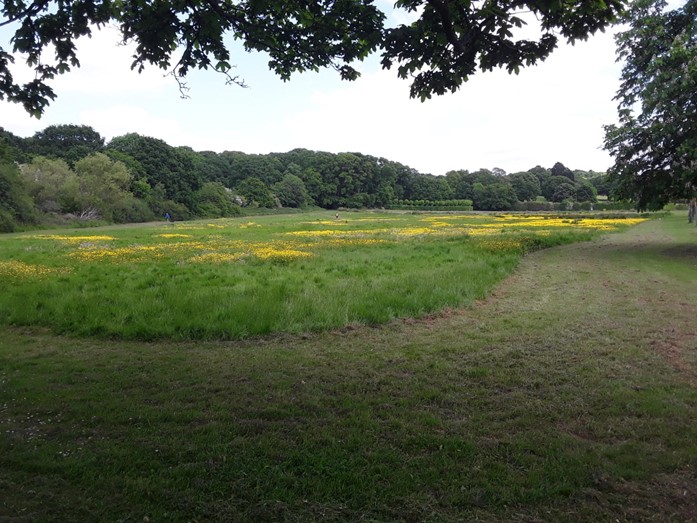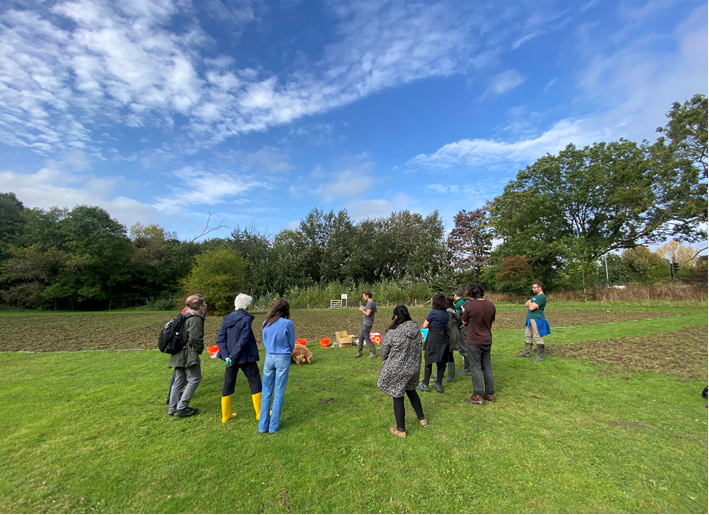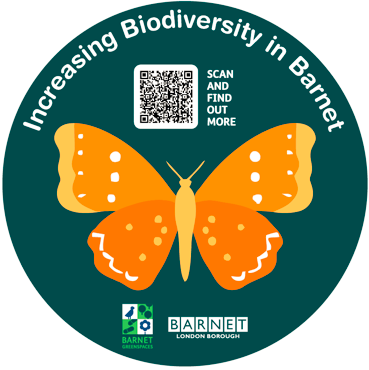Boosting Barnet’s biodiversity: a grassland enhancement project
Meadows and pastures are a traditional component of the English landscape, but flower-rich grassland habitats have declined in number by an estimated 97% over the last century.
Grassland makes up a large proportion of Barnet’s parks and open spaces. This project aims to improve the quality of the borough’s grassland, reducing mowing frequency and changing the management of suitable areas.
Biodiversity in Barnet
Reducing mowing will enhance the borough’s grassland habitats, increasing the diversity of meadow grass and native wildflower species. By reducing the frequency and carefully timing the cutting of grass, the habitat becomes more diverse, allowing pollinators and other invertebrates, small mammals, and birds to thrive.
Typical wildflowers you might see are common knapweed, lady’s bedstraw, oxeye daisy and meadow buttercup.
Management of our green spaces
No-Mow May
We have been participating in the Plant Life No Mow May™ project since 2020. Barnet’s No-Mow May sites include:
- Baring /Castlewood Road O/S (East Barnet)
- Barnet Hill O/S (Underhill)
- Barnet P.F (Underhill)
- Bethune Recreation Ground (Friern Barnet)
- Brent Green (Hendon)
- Cromer Road O/S (Barnet Vale)
- Finchley Way O/S (West Finchley)
- Friary Park (Woodhouse)
- Greenhill Park (Barnet Vale)
- King George Field (Barnet Vale)
- Lawrence Green O/S (Mill Hill)
- Lincoln Avenue O/S (Brunswick Park)
- Malcolm Park (West Hendon)
- Millfield O/S (Burnt Oak)
- Oakway and Monkfrith Way O/S (Mill HIll)
- Oakdene Park (Finchley Church End)
- Scratchwood (Edgwarebury)
- Victoria Recreation Ground (East Barnet)
- Waterfall Walk and Brunswick Park (Brunswick Park)
Amenity grassland
The amenity grassland areas - open, grassy areas managed for public use and recreation - of our parks and open spaces, as well as most road verges, have historically been cut 16 times a year. From 2025, these areas will be cut on average 8 times between March and October, still ensuring that the amenity value of the areas remains.
This was trialled in 2024 and there were no noticeable negative impacts reported on the appearance or functionality of the park facilities.
Cut and lift
‘Cut and lift’ meadow management involves cutting grass once or twice a year- and removing the grass cuttings from the site. Cuts can be done in February/March and again in September, or just once in September.
Ideally, the cut grass should be left to dry and shed seed for 1 - 7 days after the autumn cut, then removed from the site. Areas can also be left uncut as refuge area for wildlife, and to maximize the survival of invertebrates during mowing.
This management method reduces the nutrient levels in the soil, which suppresses dominant, fast-growing grass species and allows native wildflower species to grow. This increases the diversity, helping the habitat support a range of different pollinators and other native wildlife.
Existing cut and lift sites include areas of the following:
- Arrandene O/S (Mill Hill)
- Barnet Gate Wood (Edgewarebury)
- Bethune Recreation Ground (Friern Barnet)
- Bittacy Hill Park (Mill Hill)
- Brook Farm O/S (Totteridge and Woodside)
- Coppetts Exchange Triangle (Friern Barnet)
- Copthall Playing Fields (Mill Hill)
- Edgewarebury Park (Edgewarebury)
- Hadley Green (Barnet Vale)
- King George Fields (Totteridge and Woodside)
- Lyttelton PF (Hampstead Garden Suburb)
- Meadway O/S (Barnet Vale)
- The Mill Field (Mill Hill)
- Mill Hill Park Nature Reserve (Mill Hill)
- Moat Mount O/S (Edgewarebury)
- Scratchwood O/S (Edgewarebury)
- Sunny Hill Park (Hendon)
- Welsh Harp / West Hendon Playing Fields (West Hendon)
- Whetstone Stray (Totteridge and Woodside)
- Whitings Hill Open Space (High Barnet)
- Windsor Open Space (Finchley Church End)
- Woodridge Nature Reserve (Totteridge and Woodside)
Environmental cut
In 2025, we will be trialling a new ‘environmental cut’ where a flail mower is used to cut the grass once or twice a year, allowing a more diverse range of species to flower and providing a food source and habitat for pollinators and other wildlife.
Environmental cut sites for 2025
Areas of the following parks
- Hendon Park (Hendon)
- Lyttelton Playing Fields (Hampstead Garden Suburb)
- New Southgate Recreation Ground (Brunswick Park)
- The Grange Playing Fields (Totteridge and Woodside)
- Woodfield Park (West Hendon)
- Woodcroft Park (Burnt Oak)
- Watling Park (Burnt Oak)
- West Hendon Playing Fields (West Hendon)
- Stanhope Road O/S (Underhill)
Road verges
- Beaconsfield Road (Friern Barnet)
- Brent Green (Hendon)
- Castlewood Road / Baring Road (East Barnet)
- Grahame Park Way (Colindale)
- Southover Northiam Green (Woodside Park)
- The Vale (Childs Hill)
Wildflower meadow sowing
In winter 2024/2025, Barnet’s Geen Spaces team reseeded additional locations with a wildflower meadow seed mix, which contain a range of native flower and grass species typically found in meadows. These locations include an area near Coppetts Wood, an area north of the Mutton Brook, near Henleys Corner, and areas of The Grange Playing Fields. Where areas have been reseeded, a mixture of over 20 species of wildflower and 6 species of meadow grass have been sown.
Tiny Meadow
In autumn 2024, we collaborated with Earthwatch, seeding the first ever ‘Tiny Meadow’. This was made possible with help from local residents, and volunteers from Good Gym and Finchley Pollinator Project. The Tiny Meadow is north of the Mutton Brook, near Henley’s Corner, Hampstead Garden Suburb.
Community Action
This project happens in collaboration with the Barnet Greenspaces Network. Some of the chosen locations will have signage installed with links to our website, providing more information about the project.
If you have any questions, comments or suggestions, please email parks@barnet.gov.uk.



